People
Javier Peres on Why Contemporary Collectors Should Care About Tribal Art
We speak to the Berlin-based dealer about his niche passion ahead of Frieze New York, which is showing tribal art for the first time.
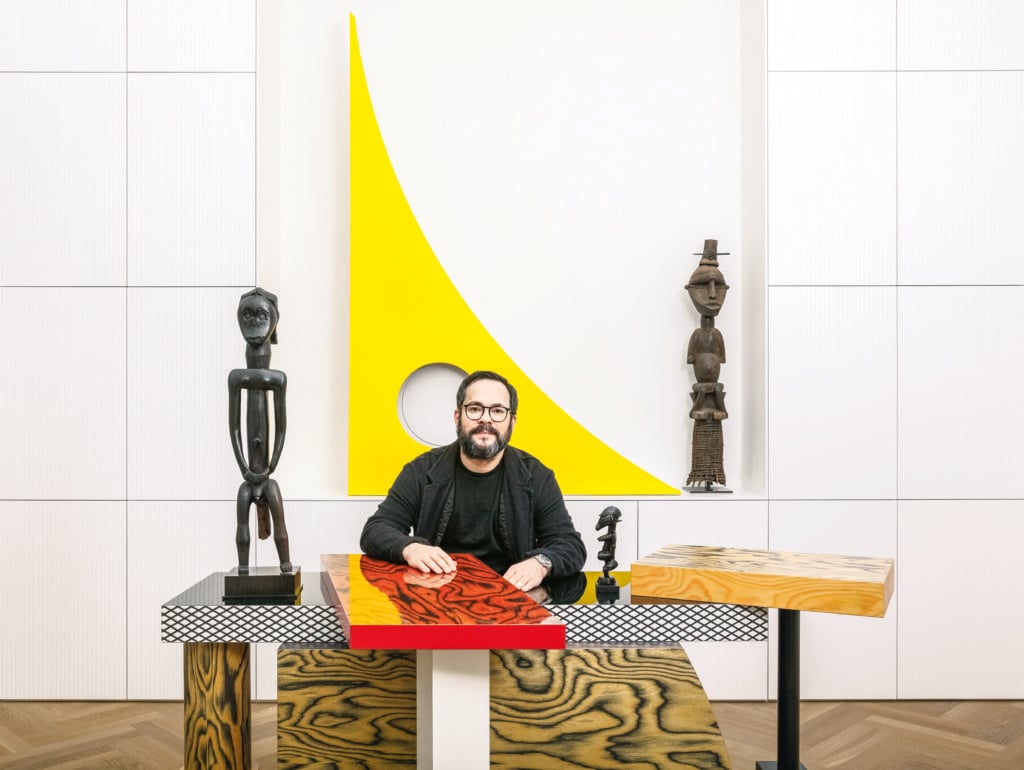
We speak to the Berlin-based dealer about his niche passion ahead of Frieze New York, which is showing tribal art for the first time.

Henri Neuendorf

This year’s Frieze New York includes a few faces that will be unfamiliar to most contemporary art collectors. For its sixth edition, which opens to VIPs on Thursday, the fair has admitted tribal art specialists for the first time.
“The decision to include tribal art galleries in Frieze New York this year evolved from the broader trends that we’ve been seeing across our exhibitors’ programs and collectors’ interests, which are growing increasingly diverse,” Abby Bangser, the fair’s artistic director for the Americas and Asia, tells artnet News in an email.
Tribal art dealers making their Frieze New York debut this year include Donald Ellis from New York and Vancouver, which will show native American drawings and artifacts; L&R Entwistle and Co. from London, which will show a selection of African and Oceanic works, including a statuette from the Baule people of the Ivory Coast; and Galerie Meyer-Oceanic Art from Paris, which is bringing a selection of early Gope Boards from Papua New Guinea.
Intimidated to dip your toe into a new field? Allow Javier Peres of Peres Projects to be your guide. As a contemporary art dealer who has collected African tribal art for over a decade, the Berlin-based American gallerist is uniquely positioned to comment on how modern and contemporary art—which itself has been heavily influenced by African art—can serve as an effective gateway drug. In February, Peres was named honorary president of the upcoming edition of the tribal art show Parcours de Monde, which he describes as “the Art Basel of tribal art.”
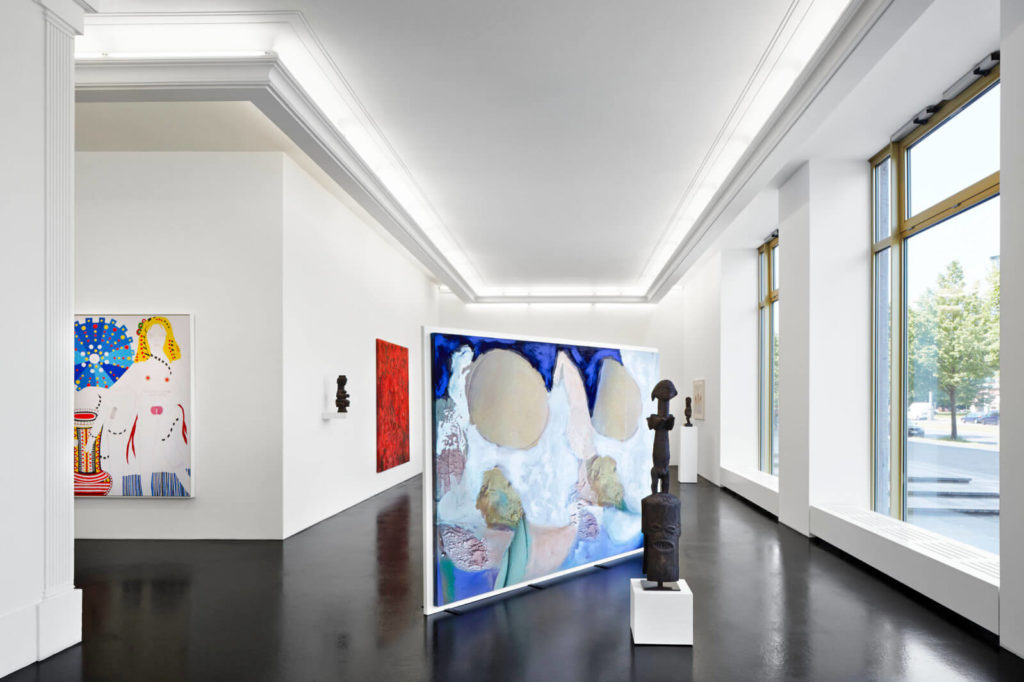
Installation view “Wild Style” at Peres Projects (2016). Photo courtesy of Peres Projects.
It’s a canny time to be looking at the field. Although it remains a niche market—auction prices for top lots hover around $5 million—Frieze’s tribal art debut comes as Almine Rech’s New York gallery opens an exhibition examining the influence of African and Oceanic tribal art on contemporary artists including Joe Bradley, Mark Grotjahn and Ana Mendieta (May 2-June 15). In the past year, Venus Over Manhattan in New York and Galerie Max Hetzler in Berlin have also mounted exhibitions that juxtapose tribal and contemporary art.
Ahead of Frieze New York, we asked Peres—who is also showing at the fair—some questions about collecting African tribal art in today’s contemporary-obsessed art world.

Eket, Nigeria. Male headdress sculpture. Photo courtesy of Peres Projects.
When did you start collecting tribal art? What attracted you to start collecting this niche?
I started around 2000, so I’ve been collecting for about 17 years. But I started studying tribal art when I was in high school. In the late ’80s and early ’90s, I got into contemporary art because I became obsessed with Jean-Michel Basquiat, and Basquiat had a lot of references to African art and ideas about African identity. At that point, I was more interested in modern art by the likes of Dubuffet and Picasso, and there was a correlation there too.
It took a good 10 years before I started buying it, because I didn’t really know how to get into it. When I was younger, I always felt it was an issue of being taken seriously in a gallery. By the time I was in my mid-20s, I was already practicing law, and I felt more confident in acquiring things and approaching people.
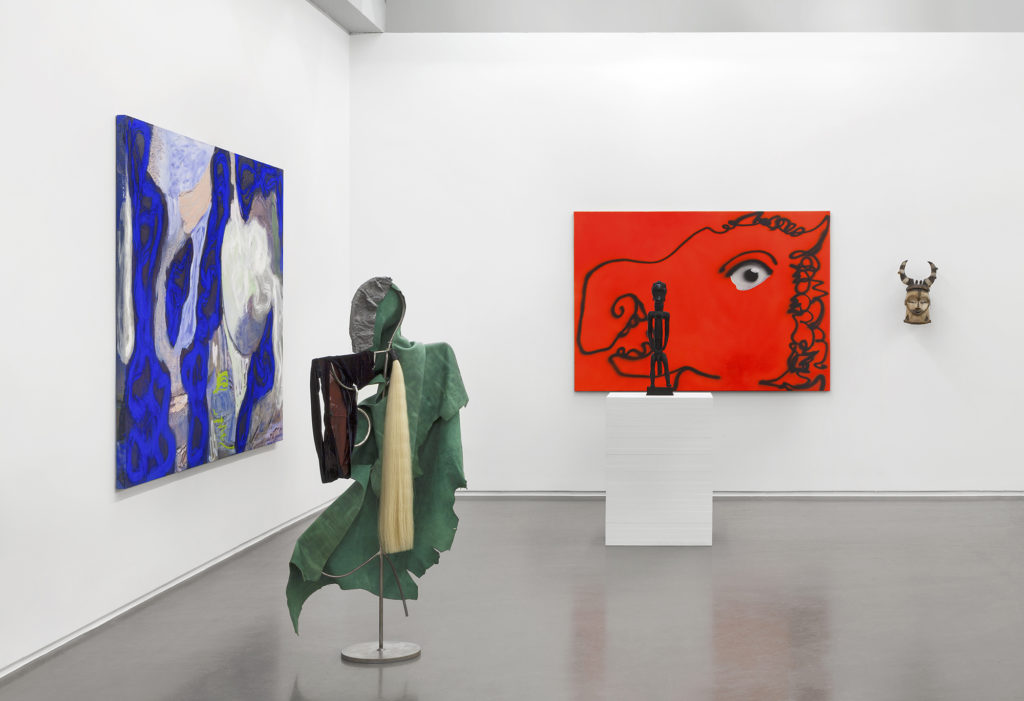
Peres Projects’ booth at Independent Brussels 2017. Photo courtesy of Peres Projects.
Tribal art is being shown at Frieze New York for the first time this year. Do you think this will broaden interest in the sector?
I hope so. I think African art has always been shown, to some degree or another, with contemporary art over the last 100 years. For example, in 1916, they were doing shows with Dan masks and Picasso in Dresden. I think it continues to be exciting for audiences to see things together. The audience for contemporary art is very smart, very curious, and given the opportunity to see things that relate to what they’re already looking at, they will be interested. From a selfish point of view, it’s helpful for me—when I exhibit at Frieze London, I can’t leave to see the African art that’s being shown at Frieze Masters.
How does the tribal art market compare to the contemporary art market in terms of price points?
I think the record for an African tribal art work at auction is either $12 or $14 million—that is the pinnacle. You can still get masterpieces depending on the type of object. And there are incredible objects that can be bought for under $100,000. Recently, Christie’s in Paris sold a really iconic Dogon mask with a figure on top that was in all the important museum shows for €2 or €3 million. It’s a chunk of change, but if you compare it to contemporary artists where we don’t even know if they’re going to be around in 20 years, then it’s not that much. So relatively speaking, the high end is in the low millions—maybe between $1-6 million—whilst in the modern and contemporary market, an edition by Koons can cost more.
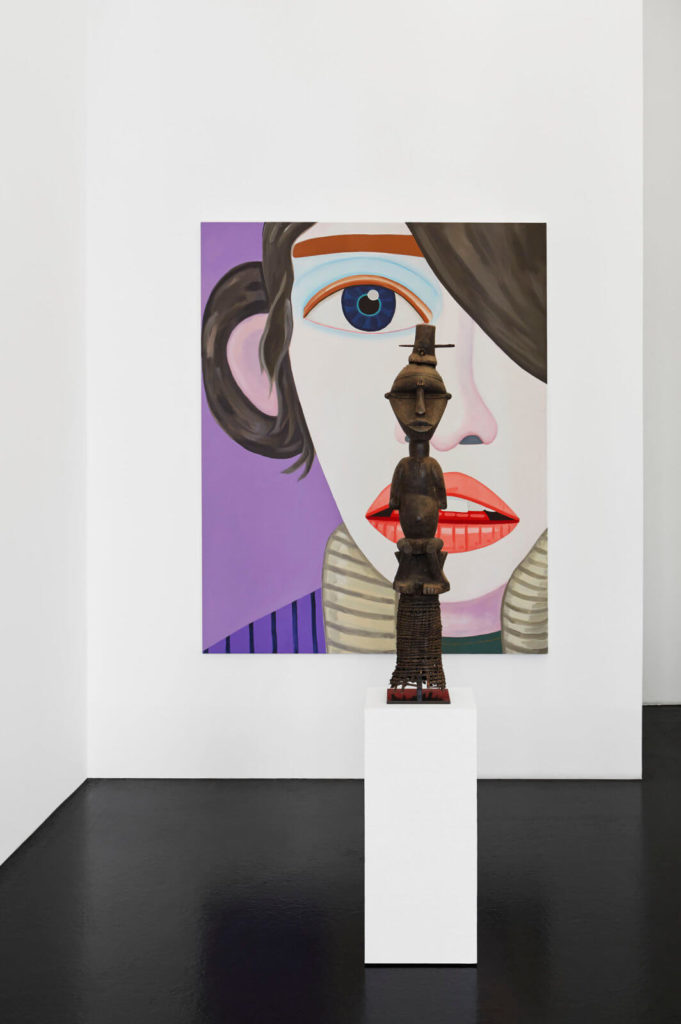
Wild Style: Exhibition of Figurative Art. Photo courtesy of Peres Projects.
How does tribal art relate to contemporary art and contemporary artists in your program?
At the Independent fair in Brussels [last month] I showed a sculpture and a mask from Gabon next to works by Donna Huanca and Austin Lee. These are young contemporary artists who aren’t directly looking at African art, but they are looking at artists who looked at African art. I am interested in the connection that continues to tie them together.
In the summer of 2014, I presented African art for the first time in my gallery along with contemporary art in an exhibition called “Group Spirit.” The exhibition highlighted the connections between contemporary abstract paintings and the coded language in the coiffures of Bunde Helmet masks from the Sande Society, an area of particular interest for me. Two years later, I presented “Wild Style,” an exhibition that focused on figuration in African art alongside contemporary art dealing with the human figure. I’m also really happy to see some important galleries getting into exhibiting contemporary art with African, Oceanic, and Tribal art.
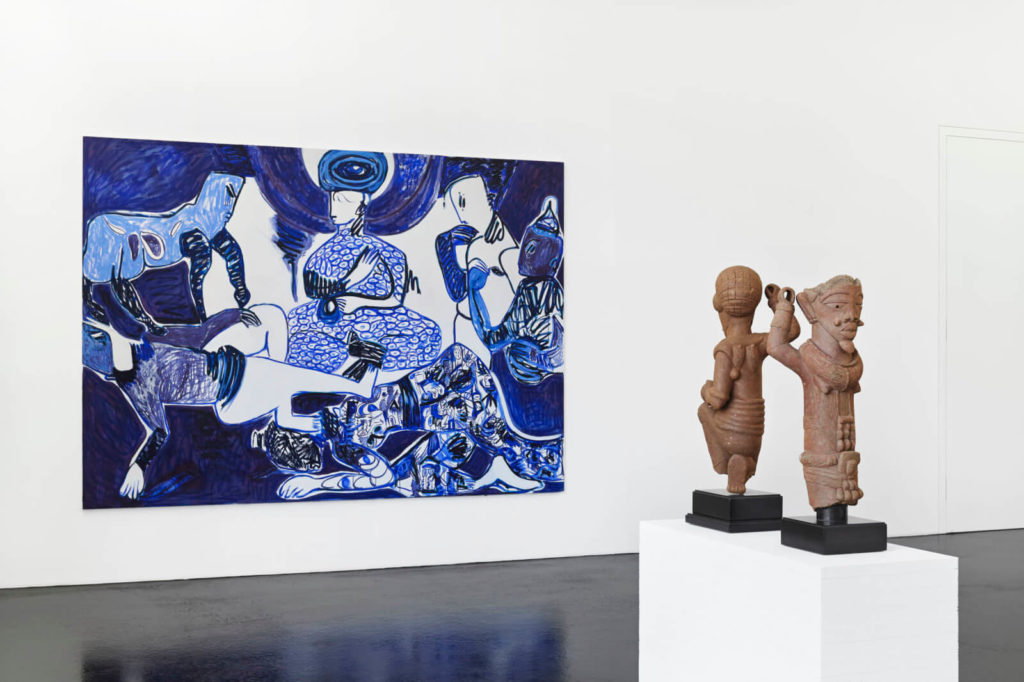
Installation view “Wild Style: Exhibition of Figurative Art.” Photo: courtesy of Peres Projects.
You’ve collected tribal art for over a decade. Why have you only recently introduced this interest into your work as a contemporary dealer? How have your artists responded?
The reason I kept things separate is because one thing is private and one is public. My contemporary business is what I do publicly, and my collection is private. At some point, I just decided that I should see if I could incorporate my collection, seeing as I always have African objects in my office. It gives me more time to spend with the objects, because the reality is that I work so much that I’m not often in my home where I keep my collection. It seems crazy to bring these masterpieces to Brussels for the fair, but for me the motivation was personal, because I got to spend more time with them there than I did last year in my home.
I’ve always discussed these interests with my artists; the interest has always been there and my artists have always known. They’ve been to my home and seen them [the objects]. I think they find it really interesting as well.
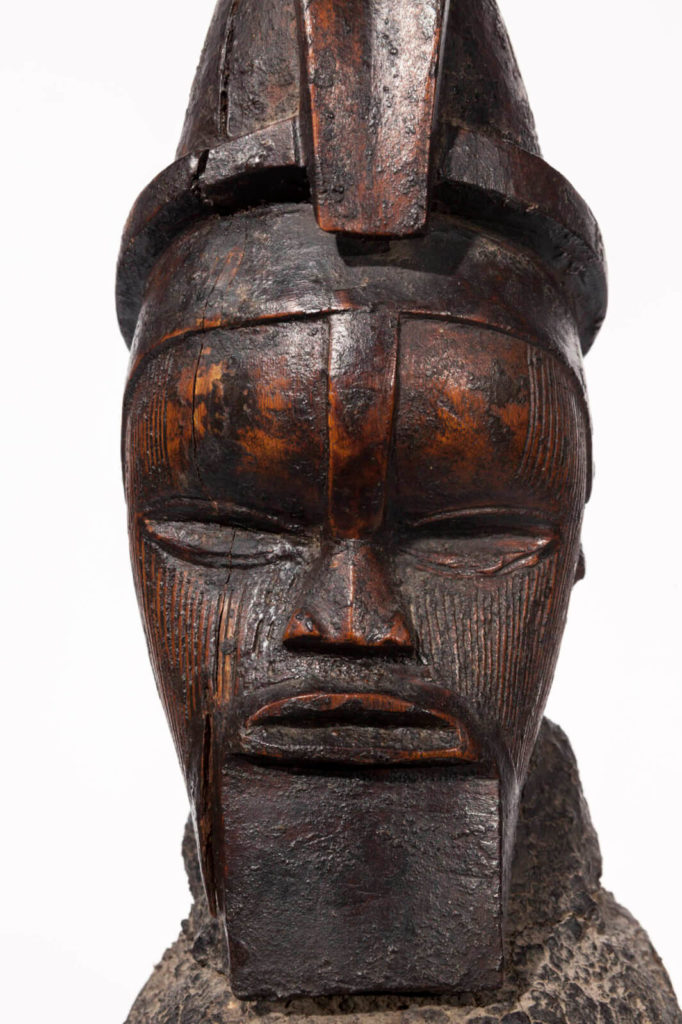
Teke, Democratic Republic of Congo. Male Reliquary Figure, by the Master of the Wedge-Shaped Beard, (ca. 19th century). Photo courtesy of Peres Projects.
How do you respond to critics who raise ethical concerns over the provenance and colonial connotations of tribal art?
I don’t have such a great response for that. I come from Cuba, a country that was colonized, and I think some of my early interest in African art was informed by my early exposure to the Yoruba culture. The provenance of objects is important to me. Although there’s certainly cases where you think that some of the objects—say from the Congo—were taken under really brutal conditions by the Belgians. It’s really awful. We are still living with the ramifications of colonization on a whole range of issues.
Within the context of these objects, when Africa was colonized by Christians or Muslims, almost everything was destroyed, and sometimes the local people were the most vocal advocates for destroying their material culture because they were being told it represented a regressive point of view about religion. So in a way, the people who actually took these objects out of those countries and brought them to Europe and America preserved that material culture that otherwise would no longer exist. This paints a complex picture but ultimately my focus has been, and continues to be, on the objects.

Installation view “Wild Style: Exhibition of Figurative Art.” Photo courtesy of Peres Projects.
Has your private collection of tribal art influenced your work as a contemporary dealer?
I think it certainly has. All of the things we come across in our lives end up permeating other aspects of our lives. I think of an artist like Donna Huanca and her ritualistic performances with painted bodies—they’re difficult to decipher but incredible to see. And now I can’t help but think of African cultures, especially with the Bassa women of Liberia who do body painting as part of rituals of the Sande society. So I think I’m sometimes attracted to contemporary artists that have the spirit of African art. I differentiate between African art and tribal art because my interest is in art from Africa, specifically. Though I admire it I don’t collect Oceanic art or Pre-Columbian art.
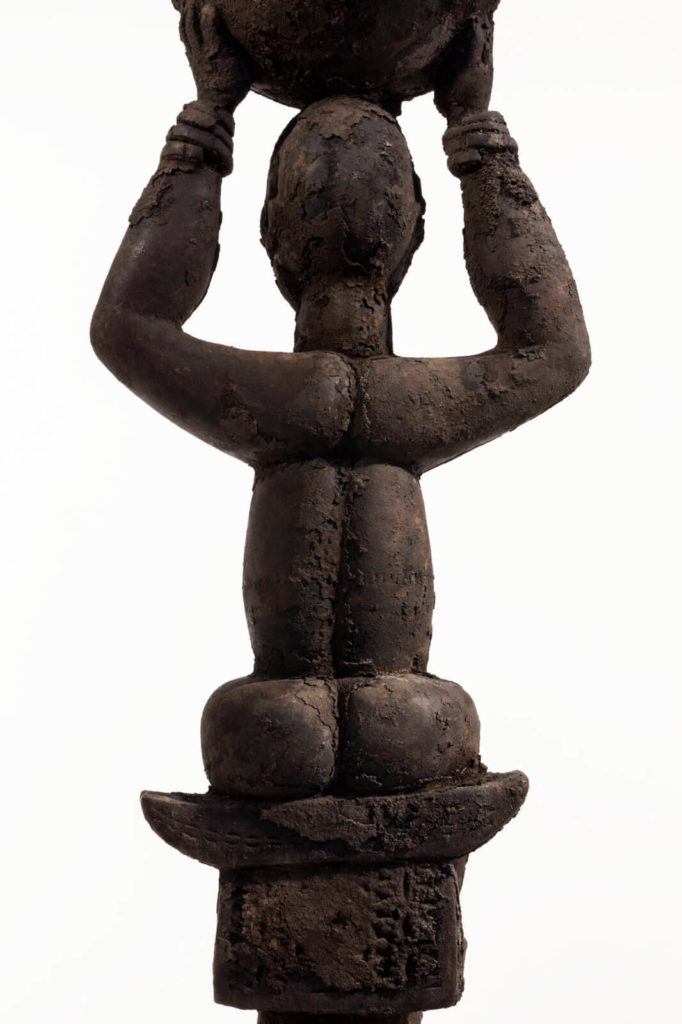
Igbo, Nigeria. Figurative Headdress. Photo courtesy of Peres Projects.
What advice would you give to new collectors interested in tribal and African art?
I think the most important pointers that I’ve been given over the years is: remember that there is always something to buy, don’t feel the need to be impulsive. You’re buying antiquities so you can spend time researching and thinking about things. When you speak to dealers try to focus on the really knowledgeable, top dealers. The three galleries that will show at Frieze in New York, for example, are all really at the top in their respective fields and are people who really know a lot and are happy to share that knowledge.
It is also important to visit museum collections and to see if you can speak to the curators—they are incredible sources of information. Having a great advisor is also key, as well as reading as many publications as possible. Finally, its really important to have a very thorough and comprehensive library. I even read about areas that I don’t actively collect. For example, I don’t collect works on metal or art from Angola, but I am fascinated by it and I study it. It provides a counter point to my more active interests and you never know what new interests will develop from this kind of study.